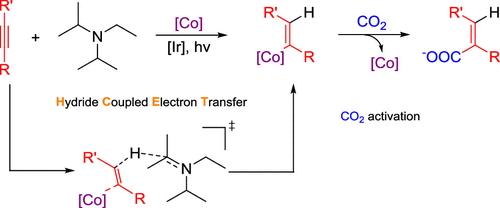当前位置:
X-MOL 学术
›
J. Org. Chem.
›
论文详情
Our official English website, www.x-mol.net, welcomes your
feedback! (Note: you will need to create a separate account there.)
Pivotal Electron Delivery Effect of the Cobalt Catalyst in Photocarboxylation of Alkynes: A DFT Calculation
The Journal of Organic Chemistry ( IF 3.3 ) Pub Date : 2020-12-22 , DOI: 10.1021/acs.joc.0c02393 Yuantai Xu 1, 2 , Yifan Shao 1 , Mårten S. G. Ahlquist 3 , Haizhu Yu 1 , Yao Fu 2
The Journal of Organic Chemistry ( IF 3.3 ) Pub Date : 2020-12-22 , DOI: 10.1021/acs.joc.0c02393 Yuantai Xu 1, 2 , Yifan Shao 1 , Mårten S. G. Ahlquist 3 , Haizhu Yu 1 , Yao Fu 2
Affiliation

|
Photocarboxylation of alkyne with carbon dioxide represents a highly attractive strategy to prepare functionalized alkenes with high efficiency and atomic economy. However, the reaction mechanism, especially the sequence of elementary steps (leading to different reaction pathways), reaction modes of the H-transfer step and carboxylation step, spin and charge states of the cobalt catalyst, etc., is still an open question. Herein, density functional theory calculations are carried out to probe the mechanism of the Ir/Co-catalyzed photocarboxylation of alkynes. The overall catalytic cycle mainly consists of four steps: reductive-quenching of the Ir catalyst, hydrogen transfer (rate-determining step), outer sphere carboxylation, and the final catalyst regeneration step. Importantly, the cobalt catalyst can facilitate the H-transfer by an uncommon hydride coupled electron transfer (HCET) process. The pivotal electron delivery effect of the Co center enables a facile H-transfer to the α-C(alkyne) of the aryl group, resulting in the high regioselectivity for β-carboxylation.
中文翻译:

炔烃光羧化中钴催化剂的关键电子传递效应:DFT计算
炔烃与二氧化碳的光羧化代表了一种高效且原子经济的功能化烯烃制备的极具吸引力的策略。然而,反应机理,特别是基本步骤的顺序(导致不同的反应路径),H-转移步骤和羧化步骤的反应方式,钴催化剂的自旋和带电状态等仍然是一个悬而未决的问题。在本文中,进行密度泛函理论计算以探讨Ir / Co催化炔烃光羧化的机理。整个催化循环主要包括四个步骤:Ir催化剂的还原猝灭,氢转移(速率确定步骤),外球羧基化和最终催化剂再生步骤。重要的,钴催化剂可通过不常见的氢化物偶联电子转移(HCET)工艺促进H转移。Co中心的关键电子传递效应使得能够容易地将H转移至芳基的α-C(炔烃),从而导致对β-羧化反应的区域选择性高。
更新日期:2021-01-16
中文翻译:

炔烃光羧化中钴催化剂的关键电子传递效应:DFT计算
炔烃与二氧化碳的光羧化代表了一种高效且原子经济的功能化烯烃制备的极具吸引力的策略。然而,反应机理,特别是基本步骤的顺序(导致不同的反应路径),H-转移步骤和羧化步骤的反应方式,钴催化剂的自旋和带电状态等仍然是一个悬而未决的问题。在本文中,进行密度泛函理论计算以探讨Ir / Co催化炔烃光羧化的机理。整个催化循环主要包括四个步骤:Ir催化剂的还原猝灭,氢转移(速率确定步骤),外球羧基化和最终催化剂再生步骤。重要的,钴催化剂可通过不常见的氢化物偶联电子转移(HCET)工艺促进H转移。Co中心的关键电子传递效应使得能够容易地将H转移至芳基的α-C(炔烃),从而导致对β-羧化反应的区域选择性高。











































 京公网安备 11010802027423号
京公网安备 11010802027423号